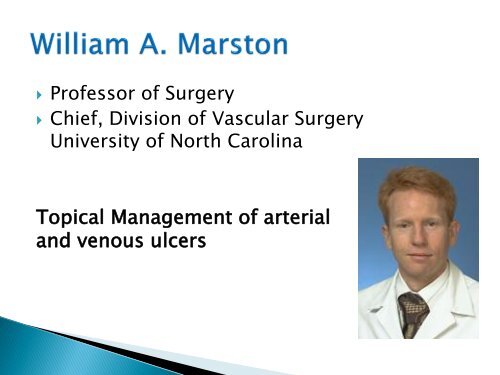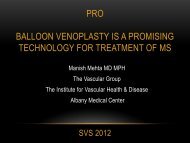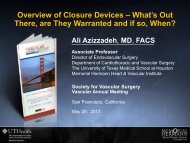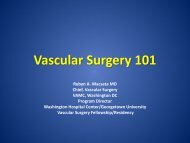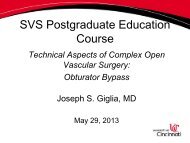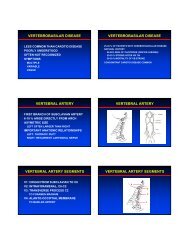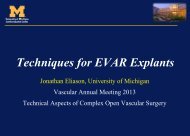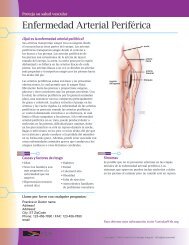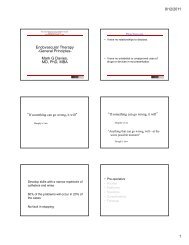Topical Management of arterial and venous ulcers - VascularWeb
Topical Management of arterial and venous ulcers - VascularWeb
Topical Management of arterial and venous ulcers - VascularWeb
Create successful ePaper yourself
Turn your PDF publications into a flip-book with our unique Google optimized e-Paper software.
Pr<strong>of</strong>essor <strong>of</strong> Surgery Chief, Division <strong>of</strong> Vascular SurgeryUniversity <strong>of</strong> North Carolina<strong>Topical</strong> <strong>Management</strong> <strong>of</strong> <strong>arterial</strong><strong>and</strong> <strong>venous</strong> <strong>ulcers</strong>
Arterial <strong>and</strong> <strong>venous</strong> <strong>ulcers</strong>:Differences in their topicalmanagementBill MarstonPr<strong>of</strong>essor <strong>and</strong> Chief,Division <strong>of</strong> VascularSurgeryUNC Hospitals
DisclosuresScientific Consultant• Organogenesis• Spiracur• Aastrom BiosciencesResearch support• Healthpoint
What do I put on the wound?• Wound gel• Hydrogel• Duoderm• Cutinova• Silvadene• Bactroban• Triple antibiotic• Santyl• Integra, primatrix,graftjacket, dermagraft,apligraf• Acticoat• Alginate• Aquacel• Iod<strong>of</strong>orm• Solosyte• Sorbsan• Curusol• healusol
Venous/lymphatic ulcer• Common assoc withobesity• Typically requirestreatment <strong>of</strong> bothetiologies• Heavily exudative• Bi<strong>of</strong>ilm issues
Arterial ulcer• Most assoc w DM• Pressure sites• Neuropathy• Tissue necrosis
• May be inatypicallocations• Typically dryunless infected• Gangrenouschanges
Combined <strong>arterial</strong> <strong>and</strong> <strong>venous</strong>• Occurs in approx20% <strong>of</strong> cases <strong>of</strong>leg ulceration• Critical to evaluateeach ulcer formultiple causes• Compressionrelated necrosisinsufficiency
Causes <strong>of</strong> Atypical WoundsInfectiousMalignancyGeneticHematologicAtypical WoundsMetabolicImmunologicInflammatoryPsychologic
Other ulcer etiologies• Vasculitis• Vasculopathy• Pyodermagangrenosum• Malignancy• Sickle Cell• Etc, etc
When to biopsy a• Long durationchronic wound• Poor response togood therapy• Looks funny• Send tissue forpath & cx
Common final pathway in chronicwounds: Unregulated inflammation• Sources– <strong>venous</strong> hypertension– Chronic pressure– Bacterial overgrowthTreatment methods– Compression0.020.0180.0160.0140.0120.010.0080.0060.0040.002– Contact cast 0TNF-a in <strong>venous</strong> ulcerNormalBefore
Rx protocol for VLU• Compression• Wound debridement/elimination <strong>of</strong>bacteria• Exudate control• Adjuvant therapies to accelerate closure• Prevention <strong>of</strong> recurrence
What type <strong>of</strong> compression <strong>and</strong>how much?• High strength elastic compression stockings• Short stretch b<strong>and</strong>age• Long stretch b<strong>and</strong>age• Unna’s paste boot• Multilayered compressive wrap– Elastic– Inelastic• Intermittent pneumatic compressionCompression must be part <strong>of</strong> any RX plan for VLU
Coexistent <strong>arterial</strong> insufficiency:How much compression?• Incidence <strong>of</strong> coexistent <strong>arterial</strong>insufficiency– Diabetic foot ulcer 50-60%– Venous ulcer 15-20%• If ABI < 0.8 or toe pressure < 70,consider reduced compression• If ABI
Pressure Offloading: TotalContact Casting• Katz et all, r<strong>and</strong>omized trial <strong>of</strong> TCC forplantar DFUs• 12 week healing rate• BUT– 93% for those who stayed in TCC at least 8weeks– 80% for all r<strong>and</strong>omized to TCC– Diabetes Care 2005;28:55-9• Only 1.7% <strong>of</strong> clinics treating patients withDFUs reported using TCCs to <strong>of</strong>floadpatients– Wu et al Diab Care 2008;31:2118
<strong>Topical</strong> therapy• Wound debridement• Control <strong>of</strong> woundbacterial levels• <strong>Management</strong> <strong>of</strong>wound drainage• Dressing selection
Why debride?• Presence <strong>of</strong> non-viable/necrotic tissue atwound edge prevents migration <strong>of</strong> newepithelium to cover wound• Debridement results in recruitment <strong>of</strong>platelets, release <strong>of</strong> PDGF, other plateletderivedfactors– Converts chronic wound to acute wound
Special considerations forpatients with <strong>ulcers</strong> <strong>and</strong> CLI• When to debride?• How much?• What about eschar?
When to debride?• In non-revasc pt,keep debridement toremoval <strong>of</strong> loose orinfected tissue• Once perfusionimproved, aggressivedebr warranted
How much to debride?
What about eschar?• Leave firmly adherenteschar in place• When edges separatefrom surroundingskin/wound, indicatestissue growthunderneath• Proceed with debrprimarily at edges
The necrotic toe
Wound bacterial load: CriticallyColonized Wounds• Debridement• Exudate management• <strong>Topical</strong> antimicrobials• Systemic antibiotics
Wound bacterial load• Bacterial count >10,000 CFUs <strong>of</strong> following speciessignificantly reduced wound closure– E. coli– Enterobacter– Enterococcus– Morganella– Pseudomonas– B-hemolytic strep• Relative risk <strong>of</strong> non-closure– Cell therapy group RR 1.4– Vehicle control group RR 5.4
• Bacteria on a surfacemultiply <strong>and</strong> secretepolysaccharide substancethat envelopes colony• Increases resistance toantibiotics, physicalstresses, endogenousdefense systems• Resistant to topicallyapplied agentsBi<strong>of</strong>ilm infections
Bi<strong>of</strong>ilm/bacterial burden
Debridement for bi<strong>of</strong>ilm control
Wound bacteria data - chronicVLU• In chronic non-healers not responding tocompression, biopsies obtained for culture in45 patients– 48% ORSA– 22% pseudomonas• Most were treated with topical silver prior tobiopsy• Systemic antibiotics based on culture &sensitivities required
<strong>Topical</strong> antimicrobials• Iodine• Dakins• Silver– Acticoat• Hydr<strong>of</strong>era blue• Other• Studies have notidentified any in vivoreduction in bacterialload or improvementin healing rates
Vulcan trial• Michaels et al Br J Surg 2010;97:459• 213 patients with <strong>venous</strong> <strong>ulcers</strong> r<strong>and</strong>omized• Silver donating dressings– Acticoat, Aquacel, Contreet• Non-silver donating dressings• All rec’d multilayer compression, other st<strong>and</strong>ards<strong>of</strong> VLU care
Vulcan: results• No difference in 12 weeks healing rates• No difference in QOL assessments• Did not report incidence <strong>of</strong> wound infection• Cost-efficacy better for non-silvercontaining dressings
What to put on the wound?• Over 5000 dressing products available forcovering wounds• Tremendous lack <strong>of</strong> comprehensiveresearch on most• Minimal regulatory requirements forapproval <strong>of</strong> dressing products• Key concept is moist wound healing <strong>and</strong>management <strong>of</strong> wound exudate
Exudate <strong>Management</strong>Wound Fluid– Acute stimulates cell proliferation– Chronic - contributes to delayed healing• increased levels <strong>of</strong> MMP’s whichdegrades the extracellular matrix• selectively inhibits proliferating cells
Demonstrated effects <strong>of</strong> chronicwound fluid• Inhibits migration <strong>of</strong> fibroblasts• Inhibits division <strong>and</strong> proliferation <strong>of</strong>fibroblasts <strong>and</strong> epithelial cells• Contains proteases that break downextracellular matrix proteins
Exudate <strong>Management</strong>Chronic Wound FluidBacterialBurdenMicrobial<strong>Management</strong>EdemaCompressionBreakdown <strong>of</strong>Necrotic tissueDebridementGoal to remove excess wound fluid from wound/skin area
Exudate <strong>Management</strong>:DressingsNone Low Moderate Heavy
Hydrogels• Gel form <strong>of</strong> saline• Supply moisture todry wounds• Gel or impregnatedgauze• Use for diabetic foot<strong>ulcers</strong>, <strong>arterial</strong> <strong>ulcers</strong>if no infection ornecrotic tissue
Hydrocolloids• Provide barrier ifmechanical shear stressan issue• Small amount <strong>of</strong>absorptive capability• Assist with debridement• Use for pressure <strong>ulcers</strong>,some traumatic wounds
Alginates, Hydr<strong>of</strong>ibers• Higher absorptivecapability• Turn into gel whenactivated by moisture• Prevent skin maceration• Use in more exudativewounds, VLUs undercompression
Foams, Specialty absorbents• High absorptivecapacity• Wick exudate awayfrom wound surface• Large, uncontrolledheavily draining VLUs
Other situations• Eschar• Debriding agents• Negative pressuredevices
Negative pressure compared tomoist wound therapy for DFUs• Blume et al• Daibetes Care2008;31:631-6• R<strong>and</strong>omized 342patients with DFUs toVAC compared tohydrogel or alginate• % closure at 16weeks45403530252015105043%VAC29%MWCP = 0.007
Summary• Determine underlyingcauses <strong>of</strong> wound• Consider ways toeliminateinflammation• Debride• Control bacterial load• Dressing based onspecific wound needs


